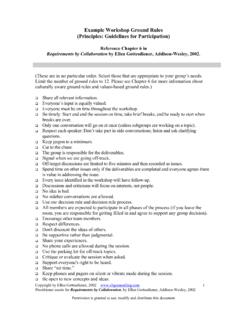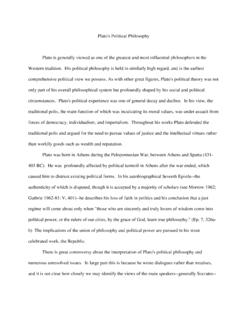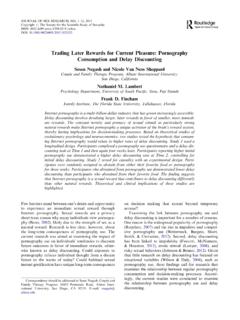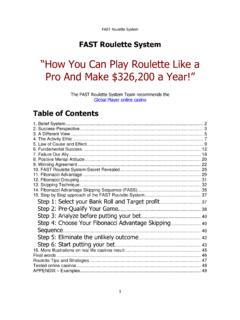Transcription of The Value of Standardization of Business Rules
1 The Value of Standardization of Business Rules By Ellen Gottesdiener and Jim Bruce Business Rules are the foundation of any Business , and standardizing their fundamentals their definitions and relationships is essential for supporting complex operations. Keeping a consistency at a higher level of abstraction is key to ensuring accurate and complete tracking. This article was published in Object Magazine, formerly a SIGS Publication March. 1998, 8 (1), Copyright SIGS Publications Business Rules concerning the life cycle of products and materials at a global manufacturer producing consumer products (referred to in this article as the Company) are embedded in over 140 applications.
2 These applications are founded on structural Business Rules which define such Business objects and component objects as: raw material, chemical material, final consumer product, etc. These myriad systems, in combination, give life to the operations of the Business , from purchasing to manufacturing bulk product to forming, filling and finishing products ready to be shipped to consumers. However, as with most large enterprises, portions of these structural Business Rules were built over the past 25 years at different times, in different places, in different vertical applications and therefore in inconsistent ways. Although the systems are highly verified, ensuring complete and accurate tracking of specific items, there is inconsistency at the higher level of abstraction.
3 A consumer product is an object type, with many subtypes and components parts. These types comprise the most basic part of the corporate Value chain - acquiring, producing, packaging, and distributing the Company s consumer products. Depending on the stage of development, a product at the company may be referenced with different terms, codes and abbreviations. The reason is that fundamental Business Rules were never standardized. Defining Business Rules The term, Business rule has different meanings for both Business and IT professionals. Within IT, Business Rules can have different connotations depending on whether the perspective is 'data-oriented', 'object-oriented' or 'expert system-oriented.
4 ' Businesspeople understand Business Rules to be the meanings of things, how they are interrelated and processing constraints around any object of the Business . A Business rule is "a statement that defines or constrains some aspect of the Business . It is intended to assert Business structure or to control or influence the behavior of the Business " (see Reference 1). These Business Rules are represented by IT analysts and designers in structural models of the applications, in such forms as class diagrams and supplemented by behavioral models ( state and process/activity/workflow diagrams). Structural Rules are modeled as terms (nouns and their meaning) and facts (the attributes, associations, types, aggregations amongst the terms).
5 In any Business , Business Rules become embedded in a variety of ways: through structure of the underlying models of an application, in procedural logic, in the manual workflow, in paper systems and in human memory. Making the Case Executive management at the Company believed that establishing commonality and maintaining consistency in the automated systems and human procedures that revolve around these fundamental Business Rules terms and facts connecting them - would yield benefits. With approximately 33,000 unique products and over 5300 SKU s (stock keeping units), it had become cumbersome to efficiently identify the same object types in the same manner in over 150 locations across the globe.
6 Today, standardizing the Rules around products and materials has become a key infrastructure program called MaPS (Material & Product Standardization ). At press time, migration activities are underway. How do you make a Business case for standardizing these fundamental Business Rules ? At this company, the answer was to do an Economic Value Added (EVA) analysis. Business Decision-making Business Rules Standardization would require many IT-related as well as Business process costs. Complicating the decision is the fact that it is extremely difficult to quantify the Business Value and return on investment (ROI) for IT projects. Nevertheless, executive management decided that the project was intuitively right.
7 In fact, they had agreed twice in the past to analyze this aspect of the Business , allowing IT to lead the effort using the top-down IT methodology known as Information Engineering. Both of these efforts, after much time and expense, yielded nice models of the data and process, but no change to systems or Business procedures. Nevertheless, executives had strong intuition that greater efficiency and decision-making would be self evident once Business Rules were normalized across the enterprise. Project Purpose With strong Business sponsorship and sound IT project management in place, a project was commissioned to "establish information management practices and mechanisms which will ensure that products and materials are identified uniquely and consistently across the entire enterprise".
8 Three key projects within the MaPS program were defined: establish standardize Business Rules and governance for those Rules , establish a technical infrastructure through a reference database to support the Rules and migrate applications to the standard Rules . The Business case was made by first standardizing the structural Business Rules with Business domain experts, validating those Rules using Business scenarios, conducting a detailed financial analysis using the ROI (return on investment) approach know as Economic Value Added, then obtaining executive approval (see Figure 1). Starting with the end in mind, a corporate set of standard Business Rules would be implemented in all systems which touch products and materials.
9 To maintain and enforce those Business Rules , Business Rules stewardship would be established. Therefore, the first step was to defining the Business Rules terms and connections among them (also referred to as terms and facts) -- for all data requirements dealing with materials and products. Road to Business Rules Definition To accomplish this goal, the Company held a series of intense facilitated workshops, involving a cross-functional team of Business experts representing the different aspects of the material and product Value chain were held. This was much more difficult than anticipated, as it required viewing product and material Rules across the whole global enterprise.
10 This in turn required a large breadth of Business knowledge, which no single person possessed. Thus, the cross-functional team was critical to defining the Business Rules . In follow-up meetings, the Rules were finalized, tested with Business scenarios generated in the workshop, and validated by a wider group of key Business experts who run the operations that use these Business Rules on a global basis. The next step was to put a dollar Value on the massive effort required to make it all happen, including the Business benefits, using an economic-based tool for decision-making. A Decision-Making Framework The decision-making framework combined solid Business insight based upon devising scenarios (stories) for the improved state of the Business , a visual map of benefits and costs called an influence diagram, and the ROI approach called Economic Value Added.





